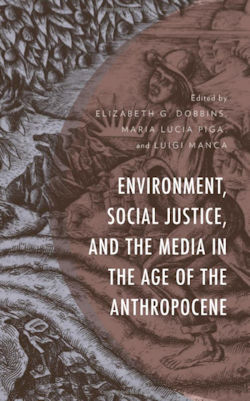SEJournal Online is the digital news magazine of the Society of Environmental Journalists. Learn more about SEJournal Online, including submission, subscription and advertising information.
BookShelf: “Environment, Social Justice, and the Media in the Age of the Anthropocene”
Edited by Elizabeth G. Dobbins, Maria Lucia Piga, and Luigi Manca
Lexington Books, $130.00
Reviewed by Rona Kobell
 |
In the 1950s, the nascent North Atlantic Treaty Organization was looking for a base to conduct military drills and testing operations. It found what appeared to be an ideal spot on Sardinia, a relatively poor farming island off the Italian coast.
CIA operatives who recommended the site described Italy as like a big aircraft carrier in front of the Mediterranean Sea. And Sardinia was without the “annoying problem of people and cities” and with a leathery population that would be “unable to organize collective action and share initiatives.”
The press would cheer the move, they believed, as the bases would bring with them hundreds of well-paying jobs. Media and government enthusiasm would drown out any shepherd, they hoped, who would object to military and economic progress.
And it was their story line that almost came to pass, as detailed in the new book, “Environment, Social Justice, and the Media in the Age of the Anthropocene.”
The story of press coverage of the Sardinia base is but one episode outlined in this new volume, part of a series of environment and society, edited by Elizabeth G. Dobbins, a Samford University biological and environmental sciences professor; Maria Lucia Piga, a University of Sassari associate professor of sociology; and Luigi Manca, a Benedictine University communication arts professor.
At times, the other essays don’t seem to break new ground, such as several chapters that center on the media’s failure to explain climate change and challenge former President Donald Trump more effectively. The book’s researchers, for instance, might have explored the possibility that complaints that some major news outlets don’t cover climate change enough might be solved by letting environment reporters who understand those parts of political stories actually cover them.
And the scholars writing in the volume might also consider how non-establishment media, too, can set the news agenda in the internet age, with their stories percolating up to major outlets (or eviscerating the same when their stories don’t meet the highest standards).
While we should continue to push for better reporting in our bedrock news organizations, we should also realize that their influence is not what it once was. People have, and do, turn to other sources, especially for environmental news.
Changing the framing
But the volume’s Sardinia chapter, its most cohesive, offers perhaps the strongest example of the media’s power in story framing.
NATO and its allies might have gotten away with their booster-ish story line if the shepherds in question hadn’t begun dying of leukemia in large numbers, their drinking water contaminated by uranium and other chemicals that NATO forces used in training exercises and building weapons.
While CIA and NATO had convinced most of Sardinia that the bases would be beneficial, as they actually proliferated — and the cancers and other diseases spread — the narrative changed. Newspapers began to chronicle the aftereffects of weapons testing, and shifted perspective about the price the population paid.
The press, once primarily interested in job growth
and progress, ultimately turned its attention to
stories of those dying of rare diseases.
The press, once primarily interested in job growth and progress, ultimately turned its attention to stories of military officers, farmers and others dying of rare diseases.
Beat reporters who needed access to the military still were more likely to tout job numbers and favorable slants, but others described in detail the suffering of the people who drank contaminated water, farmed polluted soil and paid with their lives.
In the years since the accounts, military officials have closed some bases. Had the risks been known earlier, maybe the framing would have been different. That’s a telling case study (and warning) for future reporting that makes this a useful, if uneven volume.
Rona Kobell is a science writer and editor at Maryland Sea Grant, part of University of Maryland. She is also a graduate student at the Philip Merrill College of Journalism, where she has been an adjunct professor.
* From the weekly news magazine SEJournal Online, Vol. 6, No. 4. Content from each new issue of SEJournal Online is available to the public via the SEJournal Online main page. Subscribe to the e-newsletter here. And see past issues of the SEJournal archived here.














 Advertisement
Advertisement 



